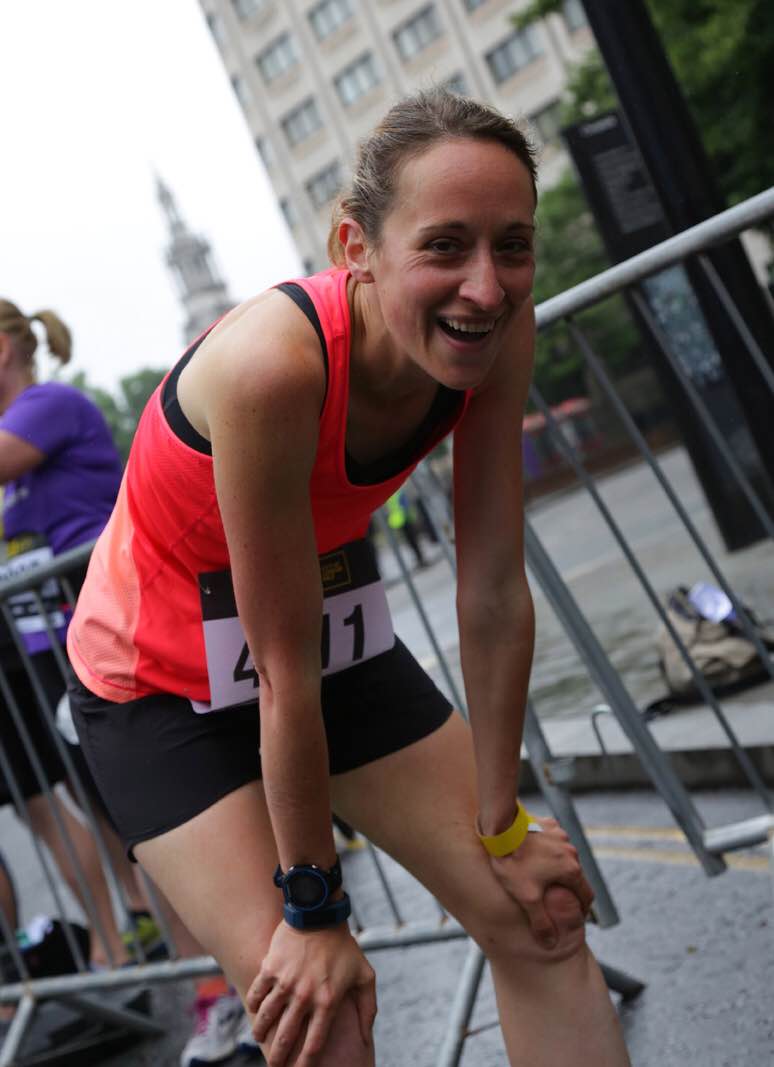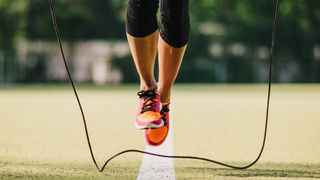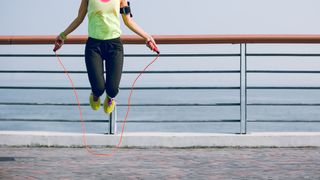The benefits of jumping rope you didn't know about—plus, five skipping routines to try
You could be missing out on all the health benefits of jumping rope


Not skipped since you were a kid? You could be missing out on all the benefits of jumping rope. It was a common school pastime for many of us, but if you haven't considered skipping since your childhood it might be time to dust off the rope as this activity is great exercise.
Jumping rope (aka skipping) is a cheap and easy way to build up your fitness level and get a high-intensity workout. All you have to do is lace up a pair of trainers (see our guide to the best running shoes for women if you're in the market for an upgrade), grab a skipping rope and get jumping!
Whether you're skipping for weight loss or just to get the endorphins buzzing, it's a workout that will make you sweat. And, it's one of the best workouts for helping you hit your weekly active minutes on your fitness tracker. Plus, there are so many more benefits to jumping rope for both your physical and mental wellbeing.
Here, an expert gives us the lowdown on the activity and shares the best beginners, intermediate and advanced skipping routines.
What are the benefits of jumping rope?
1. It's a great form of cardio
Jumping rope is a great form of cardio. It's been popular as training method in particular sports for a long time—most famously in boxing. Think Sylvester Stallone in Rocky. And many celebs over the years have mastered skipping as part of their workout routines, from Kate Hudson to Halle Berry.
Nathan Bell, owner of the independent gym Higher Level Performance, often introduces his clients to skipping for this reason. “It’s a fantastic form of developing the cardiovascular system,” he explains.
“If you can build up to 2-3 minutes and upwards of non-stop skipping you will definitely begin to feel the lungs pumping to bring oxygen to the muscles," he adds.
Sign up for the woman&home newsletter
Sign up to our free daily email for the latest royal and entertainment news, interesting opinion, expert advice on styling and beauty trends, and no-nonsense guides to the health and wellness questions you want answered.
Skipping is a tough workout but it will certainly get your heart rate up and burn fat, if weight loss is your goal. It's one of the best exercises to burn belly fat, and a great cardio alternative to the treadmill or bike if that's not your thing.
2. It builds endurance and stamina
Exercise should always be challenging, and as you overcome each challenge you build stamina and endurance. The same goes for jumping rope.
It can be frustrating to begin with—just when you think you’ve got a rhythm going, you catch the rope on your foot and have to restart. But, this is precisely what makes it a good exercise for your brain as well as your body. "In order to improve at skipping you must learn to relax, be patient and show consistency—something many of us lack in the modern-day," says Nathan.
Once you commit to the activity, progress doesn't take long. "I guarantee that almost anyone can learn to improve their skipping just by allocating five minutes a day to the exercise," says Nathan.
Learning any new skill, and seeing advances in it, can be brilliant for your self-esteem, too. And committing to it (even if it’s just five minutes a day) is a great way to establish a new fitness routine that benefits both your body and mind.
As you get more skilled, you can add different levels of difficulty and try more advanced routines, incorporating moves like high knees, heel flicks, or even rope crossovers. Just like being in the playground again! Getting back to the freedom and fun of your childhood can also be a real buzz.

3. It improves co-ordination
When starting out, people can find it difficult to time the rope with their jump, Nathan explains. "However, with practice and a little guidance, you can quickly develop your coordination and build a good rhythm. Building coordination is extremely important in sport, that's why I use skipping with almost every young athlete I work with," he adds.
Skipping can improve your concentration and coordination as you practice different skipping routines, and in turn, this can improve your performance in other exercises.
However, as with any new exercise, it is important to be sensible. You should start slowly and build up only when you feel ready, otherwise you risk injury. "Skipping is a fantastic way to practice low-level plyometrics,” explains Nathan, “But, if you're suffering from knee injuries or are significantly overweight I wouldn’t start with skipping straight away. Begin with a low-impact exercise to build up your strength, first."
Looking for a low-impact activity? Why not try yoga for beginners, or Pilates for beginners to get you started before you turn your hand to jumping rope.
4. It improves heart health
Looking after your heart health is so important. The British Heart Foundation reports heart attack symptoms in women are often missed because of the common misconception that it's a man's disease. This is simply not the case, and among a healthy balanced diet and health checks, jumping rope can help you keep your heart healthy.
Any activity which raises your heart rate will help get it stronger—your heart, after all, is a muscle that needs exercising. Regular skipping will improve your aerobic fitness, get your arteries and veins working more effectively and bring oxygen to your blood cells more efficiently.
You’ll notice this as you feel less and less out of breath while you skip and you are able to skip for longer. Aerobic activity also helps to lower your blood pressure—which is super important, as high blood pressure is one of the major risk factors for heart disease.

Why jumping rope is great for women over 40
Skipping isn't just for kids in the playground, it's also a must-try for women aged 40+ who want to incorporate something new into their exercise regime, or fall in love with fitness again.
You can skip almost anywhere—all you need is a jumping rope and space. No expensive gym equipment required. This is especially great if you're time-poor or need to fit in a workout while looking after kids or grandkids. It's something the whole family can get involved in, which makes this workout lots of fun. When traveling, you can easily fit a rope in your suitcase and have an aerobic workout to hand wherever you go.
Skipping is a great way to get back into aerobic exercise and to gently build up fitness, too. It’s encouraging how quickly you can see progress, from being able to skip for only seconds to being able to do a full half-hour skipping routine. You’ll also see huge benefits in concentration as you master the technique, which in turn boosts feel-good endorphins.
Compared to other popular cardio workouts such as running or HIIT training, jumping rope is much easier on joints which is important for women during and post-menopause. As we age, we naturally lose bone density and our muscles become weaker—this is why strength training for women is so important. By jumping rope and focusing on your form ensuring you land on the balls of your feet, you'll build muscle in your legs without putting too much pressure on your knees and joints. Plus, you'll get a good cardio workout.
However, as Nathan says if you're suffering from any injuries don't turn to jump rope right away. See a specialist and try low-impact activities to build up your strength again.
What are the best skipping routines to do at home?
There are thousands of different skipping routines you can try, here are some simple ones to get you started from Coach Nathan Bell.
Beginners skipping routines
- One minute skipping, one minute rest
- Repeat five times
- When you can skip consistently for one minute, build up to 90 seconds and then two minutes
- When you can skip consistently for three minutes, reduce the rest period to 45 seconds then to 30 seconds
Intermediate skipping routines
Continuous Cardio:
- Two minutes skipping
- Thirty seconds rest
- Repeat three - five times
- 20 seconds skipping
- 10 seconds skipping on left leg only
- 20 seconds skipping
- 10 seconds skipping on right leg only
- 30 seconds rest
- Repeat three - five times
High Intensity:
- 10 seconds skipping
- 10 seconds high knees
- Repeat 10 times
- 10 seconds skipping
- 10 seconds double skips
- Repeat 10 times
Advanced skipping routines
Continuous Cardio:
- Three minutes skipping
- 30 seconds rest
- Repeat three-five times
- 30 seconds skipping
- 15 seconds left leg
- 15 seconds right leg
- 30 seconds rest
- Repeat three-five times
High Intensity:
- 10 seconds skipping
- 20y seconds double skipping
- Repeat 10 times
- 30 seconds rest
- 10 seconds skipping
- 20 seconds high knees
- Repeat 10 times

What skipping rope do you need?
There are lots of different types of skipping rope on the market, and the best rope for you will depend on what you want to get out of your workout.
Some are lightweight and best suited to speed skipping or those who want to build up their rope jumping time. Other ropes are weighted and will give you a full-body workout by engaging your arm and shoulder muscles more. Weighted ropes can also improve core strength and posture.
If you're nervous about catching the rope on your skin, you can try softer cotton ropes over plastic ropes. You should also opt for adjustable ropes so you can ensure they are the right length for your height. If your rope is too long or too short, it will be difficult to master that all-important rhythm.
As well as a jumping rope you will also need a supportive bra for skipping, if you need a new one read our guide to the best sports bras.
Kate Carter is an experienced journalist who worked for the Guardian for a decade before going freelance. She writes for the Guardian, Runners World, and World Athletics amongst many other publications, and presents for The Running Channel. She is also a sub three hour marathon runner and an England Athletics coach.
-
 Weekly horoscope: 2 astrologers' predictions for 24th - 30th March 2025
Weekly horoscope: 2 astrologers' predictions for 24th - 30th March 2025Read your weekly horoscope from Sally Trotman and Penny Thornton who reveal what this week holds for every star sign on love, family, career, and more
By Penny Thornton Published
-
 I'm calling it, cherry blossom is the chic manicure colour of spring 2025 - and these polishes nail the look
I'm calling it, cherry blossom is the chic manicure colour of spring 2025 - and these polishes nail the lookThe bloom of cherry blossom trees is synonymous with the start of spring, so we're taking cues for our new season manicure.
By Naomi Jamieson Published
